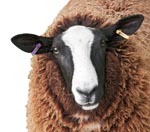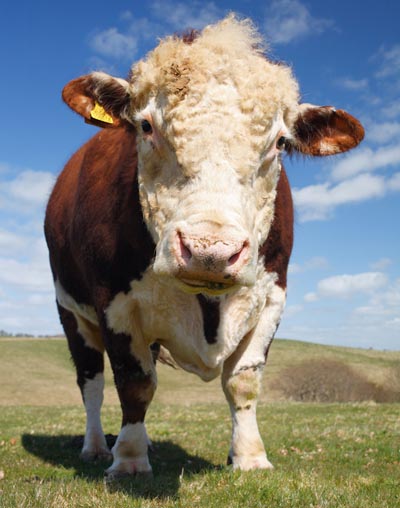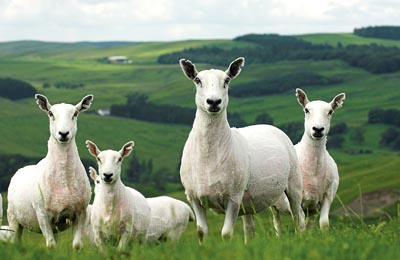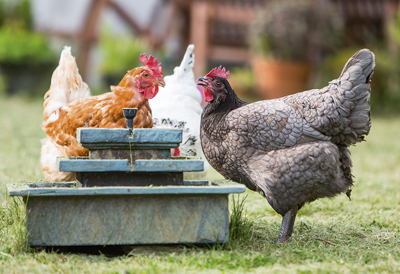The best local breeds for hobby farming
Farm local breeds wherever you live with Country Life’s guide to hobby farming in Britain


In 1823, the fiesty countryside commentator William Cobbett was much taken with the farm animals he encountered on one of his Rural Rides, across the Kent and Sussex Weald. Crossing Romney Marsh, he noted that the sheep were ‘as white as a piece of writing paper' and admired the rich red Sussex cattle. ‘How curious is the natural economy of a country!' he wrote. ‘With cattle of this kind and with sheep... this Marsh abounds in every part of it; and the sight is most beautiful.'
Once, the traveller could tell which county he was in by the animals grazing it-Herdwicks on Cumbrian fells, roman-nosed Bluefaced Leicester sheep on Midlands grassland and economically shaped Shetland cattle that could fit into a rowing boat.
As locally distinctive as stone or soil, many animals are still in situ-The Princess Royal, patron of the Gloucester Old Spot breeders' club, has the appealing pigs snuffling in a copse at her Gatcombe Park. Others, however, are long gone-26 native breeds became extinct between 1900 and 1973, swamped by fast-developing Continental breeds-but some, like the Hereford cow, have spread worldwide. All are valuable for the genetic diversity they offer as protection against disease.
‘Our native breeds are living history,' says local food campaigner Caroline Cranbrook. ‘They connect us with the past, they have shaped much of our landscape and they continue to maintain it, but their greatest value is as a genetic resource, both now and in the future. When I first came to live in Suffolk, there were fields of Red Poll cattle looking spectacular amid the buttercups. Local breeds look so right-they just fit in, unlike some of the Continental breeds you see every-where now. But it's not only that traditional breeds are beautiful-the meat they produce is unsurpassed.'
Native-breed meat can be lower in cholesterol, and the animals' often low-maintenance qualities aid conservation grazing and are ideal for budding smallholders. What is still needed, however, is greater awareness and enthusiasm to buy local, whether it's meat for the freezer or stock for your pasture.
On a Suffolk farm
Red Poll Dual-purpose, hornless breed, whose glorious deep-chestnut colour is an adornment to the East Anglian landscape (www.redpoll.org)
Sign up for the Country Life Newsletter
Exquisite houses, the beauty of Nature, and how to get the most from your life, straight to your inbox.
Suffolk sheep Black-faced, black-legged sheep that are descended from Saxon lines. They're prized for their commercial attributes and charming appearance (www.suffolksheep.org)
Ixworth chicken One for the purists, the snowy white fowl is named after the village where it was created in 1932 by Reginald Appleyard using Sussex and Indian Game strains of fowl
On a Gloucestershire farm
Gloucester cow This magnificent cow, which begs to be painted, was saved from extinction 40 years ago by a group of Cotswold farmers (www.gloucestercattle.org.uk)
Cotswold sheep Its Rastafarian locks made the Cotswolds rich in medieval times, so it's sad that it's now classified as a rare breed. You can get a better look at them this weekend (September 7) at the Moreton-in-Marsh Show (www.cotswoldsheepsociety.co.uk)
Gloucester Old Spot The ‘orchard pig', or original cottager's pig, from the watery Berkeley Vale, has definite je ne sais quoi and was the first farm breed to be accorded Traditional Speciality Guaranteed EU status-along with Parma ham and Champagne (www.gospbc.co.uk)
On a Welsh mountain farm
The prized Welsh Black cow (www.welshblackcattlesociety.com) could be responsible for the formation of Lloyds Bank; in Saxon times, its forerunner, the Bank of the Black Ox, was formed to protect the funds of Welsh farmers, who were frequently robbed on their return from England where they had sold their cattle. Among the many strains of tough, low-maintenance sheep roaming the Welsh hills, the Black Welsh Mountain, which was selectively bred in the 19th century for its red-black fleece, is perhaps the best known (www.blackwelshmountain.org.uk). Kate Humble, however, was determined to have the beautifully marked Badger Face on her Welsh farm (www. badgerfacesheep.co.uk). The handsome, rare Brecon Buff goose, developed by Rhys Llewellyn, was recognised as a breed in 1934

On a Welsh borders farm
Hereford cattle Originating in Here-fordshire in the 1700s-Queen Victoria was the first patron of the breed society-the red cow with a white face is now found in more than 50 countries (www.herefordcattle.org)
Shropshire sheep Boasts the oldest flock-book society in the UK and is a great rare-breeds success story, saved from extinction by its talent for grazing among trees without shredding them (www.shropshire-sheep.co.uk)
Clun Forest sheep In 1803, the Rev Joseph Plymley wrote that the nearer one went to Wales, the more white-faced the sheep became. However, Clun Forests have black faces and black legs, probably due to being crossed with Radnors and Long Mynds (www.clunforestsheep.co.uk)
On a Borders farm
Sheep are the furniture of the Border uplands, with such hardy local breeds as the Cheviot (www.cheviotsheep.org); the Brecknock Hill Cheviot (www.brecknockhillcheviotsheep.co.uk); the Lonk (www.lonk-sheep.org); the Roughfell, (www.roughfellsheep.co.uk); the Teeswater (www.teeswater-sheep.co.uk); the Swaledale with its ‘burglar mask' face (www.swaledale-sheep.com); and the Wensleydale (www.wensleydale-sheep.com). Hardiest of all is the Herdwick, whose wool reputedly never wears out (www.herdwicksheep.com). Most famously, however, the area produced Shorthorn cattle, whose genetics have been used to improve 40 breeds, such as the Blue Grey-championed by the Duke of Buccleuch-which is produced by mating a Whitebred Shorthorn bull with any female, but principally a black Galloway. In 1810, Comet, a legend in cattle-breeding, became the first 1,000-guinea bull and the Coates Herd-book, established in 1822 by breeder George Coates, is the oldest pedigree herdbook in the world (www.shorthorn.co.uk).

County pigs
Staffordshire The Tamworth (right) probably the brightest and funniest of pigs and the one most closely related to the ancient forest pig as it hasn't been mixed with Asian blood (www.tamworthbreedersclub.co.uk)
Oxfordshire The appealing spotted ginger Oxford Sandy & Black or ‘Plum Pudding' pig-which a few dedicated breeders saved from becoming extinct in 1985. There are only four male bloodlines: Alexander, Alistair, Clarence and Jack (www.oxfordsandypigs.co.uk)
Berkshire Originating in the Thames Valley, foreign blood has given the Berkshire pig its black colouring, perky ears and lighter build (www.berkshirepigs.org.uk)
On a Highlands & Islands farm
Northern Scotland has some of the purest native breeds, protected by their isolation. Most romantic of all is the statesmanlike Highland cow, which may have arrived with the Vikings (www.highlandcattlesociety.com).
The Shetland cow (www.shetlandcattle.org.uk) and Shetland sheep (www.shetland-sheep.org.uk), small, low-maintenance breeds, are still farmed by crofters, and the Shetland goose can survive on grass alone.
Boreray sheep, which originated on the St Kilda archipelago, are the rarest native sheep breed of all and still survive there-in a feral state-on the island of Boreray. After the islanders were evacuated in 1930, Borerays were replaced by the primi-tive Soay, thought to date from the Bronze Age, which resembles the wild mouflon of the Corsica, Sardinia and Cyprus (www.soaysheep.org).
The North Ronaldsay sheep is also extremely rare, mainly because it thrives on seaweed, which can make it susceptible to copper poisoning when farmed elsewhere.
Native Aberdeen Angus cattle are still classed as endangered by the Rare Breeds Survival Trust (RBST), but the wider breed is famed for its tasty beef, as sold in Waitrose, Marks & Spencer and Burger King. They were developed in the early 19th century from the polled and predominantly black beasts of north-east Scotland known as ‘doddies' and ‘hummlies' (www.aberdeen-angus.co.uk)
On a Sussex farm
Southdown sheep Teddy-bear-faced sheep that once roamed the South Downs. The oldest of the terminal sire breeds-those used for improving flocks (www.southdownsheepsociety.co.uk)
Sussex cattle Ancient beef cattle that inhabited the Weald of Kent and Sussex. Encountering them on one of his Rural Rides, William Cobbett described them as ‘red, loose-limbed and, they say, a great deal better than the Devonshire' (www.sussexcattlesociety.org.uk)
Sussex chicken Long-established breed, which comes in eight colours-the pretty speckled is the oldest. Popular for its friendly nature and satisfying laying potential

KEEPING IT LOCAL - RUPERT ULOTH
Fell farmers talk about hefting their sheep to the hills and when we moved to West Sussex twelve years ago we felt a good way to heft us and our family to our adopted county was to acquire livestock long associated with what Kipling called the 'blunt, bow-headed whale-backed Downs'. As many as 110,000 sheep were grazing this area as far back as 1341, the wool famous for its fineness and quality. In 1780 John Ellman set out to standardise the breed. We love their docile nature, woolly foreheads and diminutive stature and now our Sunday lunch only has to travel the few yards from the field to the kitchen. Our Light Sussex hens meet the same desire for local connections. They're not great layers but the white feathered bodies surmounted by black like a diva's neck warmer is the definition of simplistic beauty. We have aspirations to house a Sussex cow, the rich chocolatey-russet coat a delight to behold and they are meant to possess easy going temperaments. We like keeping pigs, although a pure Sussex breed doesn't' really exist now; we can compensate by feeding them Sussex apple varieties such as Alfriston or Crawley Beauty. I enjoy this reference to our ancestors. They will have experimented with breeds over generations, taking into account the local geology and geography. If it worked for them, it works for me
On a Devon farm
Exmoor Horn Its meat is now being lauded by the Mutton Renaissance Club (www.exmoorhornbreeders.co.uk)
Greyface Dartmoor Descended from ancient hill sheep, it peers out from under a corkscrew-curl fringe (www.greyface-dartmoor.org.uk)
Whiteface Dartmoor A shorter-wool version of the Greyface (www.whitefacedartmoorsheep.org.uk)
Devon & Cornwall Longwool Rarely found outside the South-West (www.devonandcornwalllongwool.co.uk), it's an amalgam of the South Devon and the Devon Longwool
Devon Closewool Originally from Exmoor, its dense fleece is weatherproof (www.devonclosewool.co.uk)
Red Ruby Devon cattle Popular beef cow, lauded for its calm nature, long-evity, fertility, ability to finish off grass and marbled meat (www.redrubydevon.co.uk)
South Devon cattle The largest British natives and known as ‘orange elephants' (www.sdhbs.org.uk) West of England goose Only standardised in 1999, it's as docile as a goose can be, so good for novice smallholders
Regional dishes
Scottish lowlands The hardy Belted Galloway or ‘beltie' with its striking wide, white girth mark is a properly local cow, descending from four original herds in Kirkcudbright and Wigtown (www.beltedgalloways.co.uk). There's also the prolific dairy cow, the handsome Ayrshire (www.ayrshirescs.org). Scotland has its own hens, the Scots Grey, which may have originated in Lanarkshire, and the delightfully named Scots Dumpy (www.scotsdumpyclub.org.uk), also known as a ‘Creepie', ‘Baikie' or ‘Daidie'-like some Dexter cattle, it has a ‘dwarfing' gene, and its squat legs means it does-n't mess up the flowerbed
North Wales Lleyn sheep, amalgams of indigenous Irish sheep, Dishley Leicesters and Texels, were imported into the Welsh peninsular by two of its largest landowners, Lloyd Edwards of Nanhoron and Lord Mostyn of Cefn Amlwch, at the start of the 19th century. The Prince of Wales has a flock of these versatile, solidly built white sheep at Highgrove (www.lleynsheep.com)
Kent The county boasts not only the much-loved Buff Orpington chicken (www.theorpingtonclub.co.uk), but also an Orpington duck, which was created, like the hen, by William Cook of the eponymous town. Nowadays, it's usually of a pleasing honey-beige colour (the drake has a brown head), the correctness of which challenges breeders. Kent has a sheep, the Romney (www.romneysheepuk.com), which was developed as a low-maintenance, marshland grazer with few wanderlust genes
Norfolk The Norfolk Grey chicken (actually black with attractive silver mark-ings) was first called the Black Maria, but this was thought too funereal during the First World War. The fowl was developed in Norwich to be a wartime food source by Fred Myhill-his ‘recipe' was a secret but is thought to owe something to the Birchen English Game
Dorset The small, curly-horned, tan-faced Portland sheep was once restricted to the Isle of Portland (www.portlandsheep.co.uk). Isolated from the sheep-breed development in the rest of Britain, it nearly became extinct, although George lll loved its mutton
Buckinghamshire Mrs Beeton's favourite roasting duck was the plump white Aylesbury, which was reared by cottagers and made to walk 40 miles to market in London, its feet protected by tar and sawdust
Leicestershire In the 1770s, Robert Bakewell, a farmer at Dishley, set about revolutionising Britain's sheep-breeding. The results were the Bluefaced Leicester (or Dishley Leicester) (www.blueleicester.co.uk), with its intelligent, domed head, now the most prolific crossing sire in Britain; the Border Leicester, the largest indigenous breed in Britain with appealing sticking-up ears (www.borderleicesters.co.uk); and the Leicester Longwool (www.leicesterlongwoolsheepassociation.co.uk). Mr Bakewell was also influential in the development of Longhorn cattle
Lincolnshire The county has lost its curly-coated pig, which became extinct in 1972, but it still has the Lincoln Red cow, described by 17th-century writer Gervase Markham as ‘fittest to labour and draft' in his book A Way to Get Wealth (www.lincolnredcattlesociety.co.uk). It also boasts the Lincolnshire Buff chicken (www.lincolnshirebuff.co.uk) and the Lincoln Longwool sheep (www.lincolnlongwools.co.uk)
* Follow Country Life magazine on Twitter
Country Life is unlike any other magazine: the only glossy weekly on the newsstand and the only magazine that has been guest-edited by HRH The King not once, but twice. It is a celebration of modern rural life and all its diverse joys and pleasures — that was first published in Queen Victoria's Diamond Jubilee year. Our eclectic mixture of witty and informative content — from the most up-to-date property news and commentary and a coveted glimpse inside some of the UK's best houses and gardens, to gardening, the arts and interior design, written by experts in their field — still cannot be found in print or online, anywhere else.
-
 380 acres and 90 bedrooms on the £25m private island being sold by one of Britain's top music producers
380 acres and 90 bedrooms on the £25m private island being sold by one of Britain's top music producersStormzy, Rihanna and the Rolling Stones are just a part of the story at Osea Island, a dot on the map in the seas off Essex.
By Lotte Brundle
-
 'A delicious chance to step back in time and bask in the best of Britain': An insider's guide to The Season
'A delicious chance to step back in time and bask in the best of Britain': An insider's guide to The SeasonHere's how to navigate this summer's top events in style, from those who know best.
By Madeleine Silver